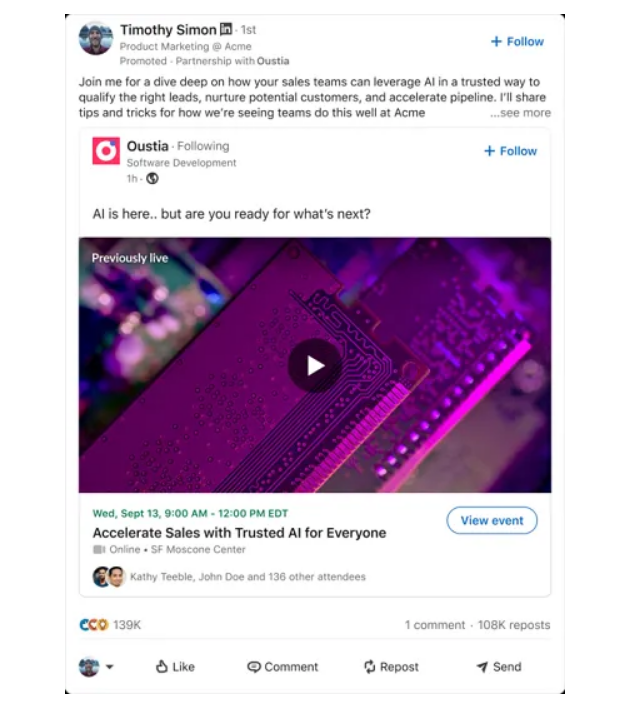LinkedIn has quietly upgraded its advertising toolkit by making its Thought Leader Ads more accessible, easier to manage via the platform’s Campaign Manager interface, and better aligned with brand-awareness and engagement goals. For organizations investing in B2B social outreach, this update signals a refinement in how LinkedIn wants brands to connect with professional audiences through individual voices—not just corporate pages.

What Are Thought Leader Ads?
Traditionally, LinkedIn’s Thought Leader Ads allowed companies to promote content created by their own employees—helping position them as subject-matter experts and driving trust through humanised posts rather than brand-first messaging.
Key features:
- You select an existing post from a qualifying LinkedIn member (often an employee or industry expert) via Campaign Manager’s “Browse existing content” function.
- The campaign objective must be Brand Awareness or Engagement (not direct lead generation or conversions).
- Formats are limited to single-image or video posts (no carousel document ads, at least initially).
In early benchmarks, LinkedIn found that Thought Leader Ads had around 1.7× higher click-through rate and 1.6× higher engagement rate compared to standard single-image ads.
What’s New in This Update
While Thought Leader Ads have existed for some time, LinkedIn’s latest changes focus on accessibility, workflow integration, and broader creator-driven approaches:
Easier Access via Campaign Manager
Brands now have a more seamless path in Campaign Manager: select your campaign objective, choose “Browse existing content”, filter by posts from individuals affiliated with your brand (or beyond in some markets), and request approval directly from the creator—all within the ad workflow.
Expanded Eligible Creators
Earlier restrictions limited promoted posts to company employees. Now, in select markets, brands may sponsor posts from non-employees who are industry experts or affiliated creators—broadening the pool of voices it can tap.
Humanising B2B Branding
This update underscores LinkedIn’s strategy: build brands through real voices, not just logos. By promoting posts authored by actual people—executives, creators, industry leaders—platform trust improves and audiences engage more deeply. Research shows that professionals tend to trust expert content from individuals more than promotional-heavy brand assets.
Workflow & Measurement Enhancements
Beyond ad format changes, LinkedIn is improving how the mechanic sits within Campaign Manager—making it easier to track sponsored posts, measure their performance, manage permissions from creators, and iterate campaigns based on actual engagement trends.
Why This Matters for Brands & Creators
1. Credibility-Driven Marketing Wins
In crowded B2B landscapes, trust and authenticity are differentiators. Using a thought leader’s post rather than a brand advertisement can help your message land with more relevance.
2. Leverage Existing Content
Rather than creating new creatives, you can tap a high-performing post from a credible voice and boost it—saving creative cost and maximising social proof.
3. Targeted Reach, Not Just Reach
Since the post comes from a known voice, your campaign may enjoy higher relevance scores, better engagement, and deeper community reactions—advantages when meaningful connections matter more than sheer impressions.
4. Multi-Account Testing and Scale
For agencies or enterprise marketers managing multiple personas, industries or geographies, it’s worthwhile to set up segmented profiles, test different voice-led posts and measure which resonate most. A structured approach helps maintain brand integrity while scaling voice-driven campaigns.
How to Get Started: A Step-by-Step Guide
Step 1: Identify the Thought Leader Post
- Search for content from creators within your organisation or industry whose posts get strong organic engagement.
- Within Campaign Manager: go to your campaign > Ad setup > Browse Existing Content > Posts tab to find member posts.
- Request creative permission from the author and wait for approval.
Step 2: Set Up Campaign
- Choose campaign objective: Brand Awareness or Engagement only.
- Choose ad format: single image or video post (as per LinkedIn’s specs).
- Set budget, targeting, schedule and creative (the selected member post).
Step 3: Optimise Audience & Creative
- Target relevant job titles, industries or seniorities to align with the thought leader’s voice.
- Ensure the creator’s profile is complete, in “Creator Mode” if applicable, and shows authority.
- Choose a post less than 30 days old for freshness and relevance.
Step 4: Monitor & Iterate
- Track engagement rates, following growth for the creator, and downstream interactions (comments, shares, conversions).
- Compare Thought Leader outcomes vs standard brand ads: CTR, engagement per £, follower lift.
- Use insights from high-performing posts to plan next campaigns with other creators or vertical target audiences.
What to Watch Out For
- Objective limitation: The format is currently not eligible for direct lead-generation or conversion-only campaigns—just brand awareness and engagement.
- Creator permissions: The creator must approve the sponsorship and may revoke it later. If they revoke, the ad stops immediately.
- Authenticity risk: If the creator’s voice and the brand’s messaging diverge, audiences may sense inauthenticity. Choose trusted voices aligned with brand values.
- Budget discipline: Thought Leader Ads may produce better engagement but still need proper targeting and creative to deliver ROI.
- Platform evolution: LinkedIn, like other social platforms, will continue tweaking formats. Stay current with Campaign Manager updates.
Final Thoughts
The revamped Thought Leader Ads format elevates LinkedIn’s value for brands that want to speak to professionals through trusted individuals, not corporate avatars. If you’re responsible for B2B marketing, this is your chance to rethink how you build reach, trust and influence.
Start by identifying credible voices within your organisation or industry, test a Thought Leader campaign, measure the lift compared to standard brand ads. If you see traction, scale voice-based sponsorships across multiple personas or regions while maintaining fidelity to your brand identity.
In an era where people buy from people, not logos, Thought Leader Ads provide a timely tool. If used thoughtfully, they can create meaningful engagement and brand lift on the professional network that matters.
